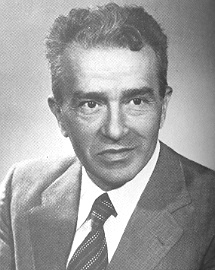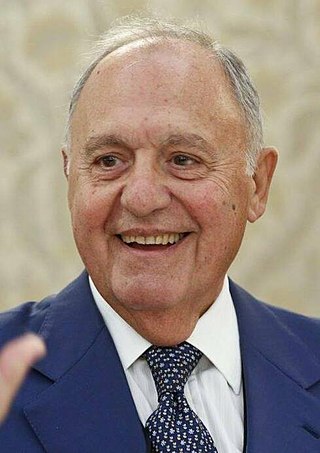Related Research Articles

Gianfranco Fini is an Italian politician who served as the president of the Italian Chamber of Deputies from 2008 to 2013. He is the former leader of the far-right Italian Social Movement, the conservative National Alliance, and the center-right Future and Freedom party. He was Deputy Prime Minister and Minister of Foreign Affairs in Silvio Berlusconi's government from 2001 to 2006.

Pietro Ingrao was an Italian politician and journalist who participated in the Italian resistance movement. For many years, he was a senior figure in the Italian Communist Party (PCI).

The Nuclei Armati Rivoluzionari, abbreviated NAR, was an Italian terrorist neo-fascist militant organization active during the Years of Lead from 1977 to November 1981. It committed over 100 murders in four years, and had planned to assassinate the politicians Francesco Cossiga, Gianfranco Fini and Adolfo Urso. The group maintained close links with the Banda della Magliana, a Rome-based criminal organization, which provided such logistical support as lodging, false papers, weapons, and bombs to the NAR. In November 1981, it was discovered that the NAR hid weapons in the basements of the Health Ministry. The first trial against them sentenced 53 people in May 1985 on charges of terrorist activities.
The Battle of Valle Giulia is the conventional name for a clash between Italian militants and the Italian police in Valle Giulia, Rome, on 1 March 1968. It is still frequently remembered as one of the first violent clashes in Italy's student unrest during the protests of 1968 or "Sessantotto".

Autonomia Operaia was an Italian leftist movement particularly active from 1973 to 1979. It played an important role in the autonomist movement in the 1970s, alongside earlier organisations such as Potere Operaio, which was created after May 1968, and Lotta Continua.

Franco "Giorgio" Freda is one of the leading neo-Fascist intellectuals of the post-war Italian far-right. He founded a publishing house for neo-Nazi thought, and described himself as an admirer of Hitler. He was convicted but later acquitted for lack of evidence for involvement in the Piazza Fontana bombing. He founded the Fronte Nazionale, which was disbanded by the Italian government in 2000 when Freda and forty-eight other members were found guilty of attempting to re-establish the National Fascist Party.

Vittorio Foa was an Italian politician, trade unionist, journalist, and writer.

Paolo Savona is an Italian economist, professor, and politician. He was the Italian Minister of European Affairs from 1 June 2018 until 8 March 2019, his second stint in government after 1993–1994. During the 2010s, Savona became one of the most fervent Eurosceptic economists in Italy.
The Right group, later called Historical Right by historians to distinguish it from the right-wing groups of the 20th century, was an Italian conservative parliamentary group during the second half of the 19th century. After 1876, the Historical Right constituted the Constitutional opposition toward the left governments. It originated in the convergence of the most liberal faction of the moderate right and the moderate wing of the democratic left. The party included men from heterogeneous cultural, class, and ideological backgrounds, ranging from British-American individualist liberalism to Neo-Hegelian liberalism as well as liberal-conservatives, from strict secularists to more religiously-oriented reformists. Few prime ministers after 1852 were party men; instead they accepted support where they could find it, and even the governments of the Historical Right during the 1860s included leftists in some capacity.
The Democratic Fascist Party was a clandestine Italian fascist political party. The party is known mainly because its founder and some other members stole the dead body of Benito Mussolini from the Cimitero Maggiore in Milan.
Costantino D'Orazio is an Italian art critic and curator.

The Ordine Nero was an Italian terrorist fascist group founded in 1974 following the dissolution of the fascist Ordine Nuovo. Between 1974 and 1978, bombings by ON led to a number of woundings and deaths, having orchestrated several deadly bombings and murders including the 1974 Italicus Express Bombing and the 1974 Brescia Bombing.

A far-right social centre is a space inspired by neo-fascist and Third Position ideas, typically in the 21st century.
Social Right was a cultural association and faction within Brothers of Italy. Its leader is Luca Romagnoli.
The Fasci di Azione Rivoluzionaria, abbreviated FAR, was an Italian neofascist paramilitary organization founded in 1946. FAR was the first neofascist group in Italy which led an armed struggle after the collapse of the Fascist Regime.
Youth Action was the youth wing of National Alliance.

The Youth Front was the youth wing of the Italian Social Movement from 1971 to 1996.
The Young Italy was the youth wing of the Italian Social Movement from 1954 to 1971.

The assassination of Sergio Ramelli was a political crime that took place in Milan, Italy, in 1975, during a period of violent and often deadly confrontations between rightists and leftists in the country at the time.

Student Action is a far-right student movement in Italy, formerly connected to National Alliance and since 2016 to Brothers of Italy.
References
- ↑ cfr. pag. 67 di Almanacco di Storia illustrata, 1968
- ↑ von Kempis, Stefan. "'The Long '68'. Italy's View of the Protest Movement of 40 Years ago" (PDF). www.kas.de. Retrieved 19 May 2016.
- ↑ Marino, Giuseppe. "ITALY: "WE DEMAND THE IMPOSSIBLE"" (PDF). www.ghi-dc.org. Archived from the original (PDF) on 8 March 2016. Retrieved 3 May 2016.
- ↑ Nicola Rao, La fiamma e la celtica, Sperling & Kupfer Editori, 2006
- ↑ Nicola Rao, La fiamma e la celtica, Sperling & Kupfer Editori, 2006
- ↑ annipiombo07
- ↑ Vi è poi chi ha ritenuto di leggervi anche una valenza contestatrice nei gruppi di destra verso il MSI-DN: Giorgia Meloni, Il Sessantotto visto da destra (L’Occidentale, 25 November 2007).
- ↑ Giampiero Mughini, Il grande disordine, 1998, Mondadori.
- ↑ Luca Codignola, Il Sessantotto fu una rivolta generazionale ma fino ad un certo punto (L'Occidentale, 9 December 2007).
